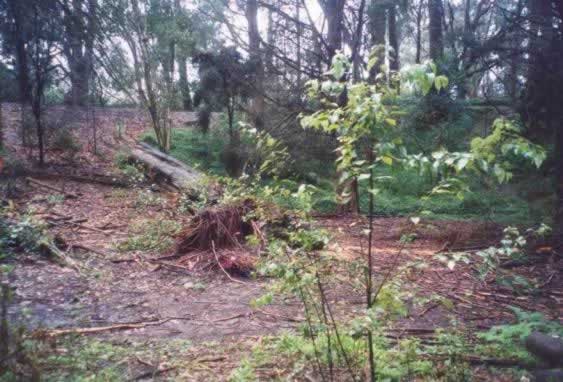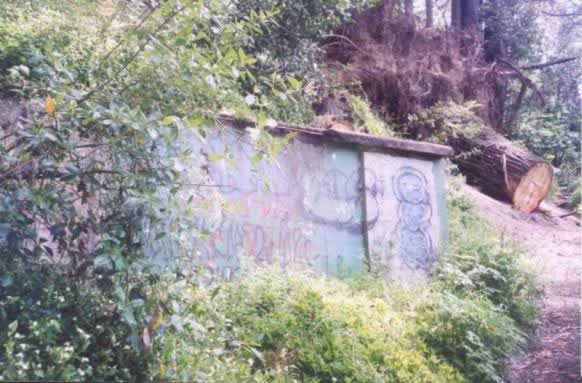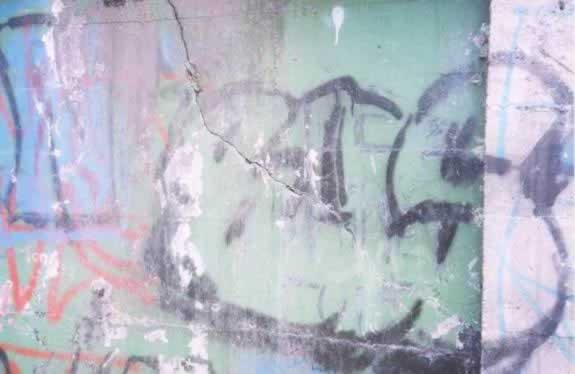AR9 – The RNZAF Fuel Depot in Cambridge
Not many residents today realise that Cambridge played host to a secret military unit during the war, a fuel depot known as AR9. The code AR9 stood for Aviation Reserve No.9.
The purpose of the depot was to store aviation fuel in a location away from any airfields and in a hidden and secret location in case of enemy bombing. In the case of an invasion or attack, a key target would be to bomb fuel tanks. So rather than have all the fuel obviously stored on the airfields that used them, certain Aviation Reserve Depots were created around New Zealand in places that the enemy would be unaware of.
To give a idea of where all these depots were situated, the following list of RNZAF Aviation Reserve Fuel Depots comes from the excellent book Defending New Zealand: Ramparts on the Sea 1840-1950s Volume 2 by Peter Cooke.
Depot Air Station
No.1 Milson
No.2 Nelson
No.3 Woodbourne
No.4 Ashburton
No.5 Ohakea
No.6 Waipapakauri
No.7 Whenuapai
No.8 Seagrove/Ardmore
No.9 Rukuhia
No.10 Gisborne
No.11 [Dannevirke]
No.12 Masterton
No.13 Woodbourne
No.14 Woodbourne
No 14A Woodbourne
No.16 Te Pirita
No.17 [Paekakariki]
Location
Palmerston North
Port of Nelson
Picton
Shell Depot
Kakariki
Okaihau
Swanson
Wiri Mountain
Cambridge
Ormond
Private Land - not built
Kopuaranga
Blenheim - not built?
Picton
Grovetown
Bankside
Transmission Gully
Capacity (gals)
500,000 gals
350,000 gals
345,000 gals
500,000 gals
600,000 gals
120,000 gals
350.000 gals
700,000 gals
600,000 gals
180,000 gals
180,000 gals
350,000 gals
11,000 gals
750,000 gals
350,000 gals
Remarks
in Atlantic Depot
in Shell Depot
in Shell Depot, no blast wall
in disused railway tunnel
in rail yards
Sisters of Mercy land, no blast wall
for planned US bomber base
diesel for US camp?
As a footnote: This paragraph comes from a larger report in the Waikato Independent newspaper dated the 25th of February 1944, which dealt with various points that arose at a meeting of the Cambridge Borough Council that week.
Works Committee.
"The Works Committee recommended that letters be written to the Railway Department, R.N.Z.A.F. and the Domain Board, calling upon them to have the gorse and blackberries cleared from their respective properties fronting on Queen Street East and Albert Street.
It is interesting to find that the RNZAF land was untidy. That's not liek the Air Force at all.
The late local resident Ernie Gorringe was in the RNZAF and was based at the nearby city of Hamilton. He worked in the Transport Section, and through his work became privy to a certain amount of information about the site, which has largely been forgotten these days.
Another local, Jim Wilkinson, remembers AR9 being built. He says the Public Works Department men who were at the time engaged in the construction of the nearby Karapiro Hydro-Electric dam were brought in to build the fuel store, which was situated between the Cambridge railway yards and Lake Te Koutu. Today the railway yards are much the same as they were in the 1940's, despite the removal of the station in the 1960's, and then the line in the 1990's. The lake too has changed little, despite having been renamed in the 1990's by the political correctness movement to Lake Te Ko Utu. So despite the passing of 60 years, some evidence can still be seen of the existence of AR9.
A lot of earth had to be shifted, and Jim recalls that most of the sandy soil was shifted across Queen Street to the St Peter's Convent School, where it was used to remedy what had previously been rather swampy ground. Jim says that the labourers and drivers worked on the project in shifts continuously 24 hours a day, but the foremen didn't. This being the case, Jim says some locals were able to take advantage and arrange for a load of sand to be dumped at their home at 3 o'clock in the morning, when the bosses couldn't catch them.
The earth was being removed so that a large fuel reservoir capable of holding 600,000 gallons, could be sunk into the ground. This tank was hidden under the canopy of gum trees and other fast growing vegetation that was planted around the tank and to act as aerial camouflage for the secret facility. A railway line siding, which is still there in the railway yard, was laid to allow fuel trains to leave the main line and position themselves adjacent to the tank, and the train could then empty the fuel it carried into the reservoir. Ernie says he assumes that the trains must have come into unload at night for maximum secrecy and protection from the air.
Meanwhile down below beside the lake itself, tanker trucks would drive in and fill their own tanks with the fuel, which travelled to them from the reservoir, down the slope via a pipeline that ran through a concrete tunnel construction.
This tunnel entrance remains visible today, though it has been blocked up since the late 1970's, and wears the battle scars of both graffiti artists and cracks from a recent fallen tree that crashed down across it after a high storm. Hoses would have run from this concrete structure to the trucks.
Ernie says that on the lower level where the trucks would enter, using the same gateway that exists today, there was also a hut where two armed guards were always stationed. These guards were airmen attached to AR9 from RNZAF Hamilton.
Sadly in the early hours of the morning of the 14th of October 1943 tragedy struck AR9. Ernie recalls that one of the guards had gone off to the pictures while the other stayed at the hut. A fire broke out, probably caused by a cigarette, in the barrack hut where the two guards normally slept. The fire was discovered at 2.40am and was blazing fiercely. The building was completely destroyed. Cambridge Police Constables H.C. Maisey and F. Solly searched the ruins and found the charred body of LAC Richard Edward Isaacs, NZ423975. He was just 20 years old. An inquest for purposes of identification was opened at Cambridge before Mr S.L. Paterson S.M., and adjourned. LAC Isaacs was the son of David Nathan Isaacs, and of Marjorie Rose Isaacs (nee Saunders), of Eastbourne, Lower Hutt. He was buried in the Karori Cemetery in Wellington, grave reference 12. I/3. (S).
Ever since the war, odd rumours have abounded in Cambridge about the remains of the concrete tunnel. Perhaps because of the secrecy and security surrounding the fuel depot, locals have forgotten, or maybe never knew, the true purpose of the facility. So over the years the tunnel entrance has become known to generations of Cambridge children (and many adults!) as ‘the bomb shelter'. It of course was not a bomb shelter at all.
An even sillier story has persisted to legendary status, which says the tunnel was an escape tunnel that ran all the way to the Town Hall, which would be used in case there was an air raid and the mayor needed to escape.
Another story purports that the tunnel ran even further to the Post Office, and an equally ludicrous rumour that has surfaced is that it ran in another direction altogether, all the way to the slope beneath Fort Street. This latter story evolved because another ‘mysterious' concrete structure, locally known as ‘the goat shelter', protrudes from the hillside. People assumed it was the other end of the ‘tunnel'. In reality the ‘goat shelter' was probably simply a drain!
None of these stories are true of course; the bare fact is it only ran a very short distance. The fact that the reservoir had been removed after the war no doubt added to the lack of understanding. My father, Gordon Homewood, recalls going into the tunnel for a look back in the late 1950's or early 1960's. He says that the tunnel he entered (there are two entrances, so perhaps two separate tunnels?) goes back a fair way, perhaps 20 feet or so, and was big enough to stand up in. He said that the shaft then goes virtually vertically upwards, which of course would have contained the piping up to the reservoir tank.
What was the purpose of AR9? Ernie Gorringe says that aviation fuel was stored there as reserve fuel, and the tankers would take it off to be used in aircraft at RNZAF Station Rukuhia (now Hamilton International Airport). Rukuhia was the site of the RNZAF's main repair depot for aircraft, No 1RD. Most large overhauls, conversions and repairs were facilitated at Rukuhia, so fuel was needed for test flying the completed aircraft. RNZAF Hamilton was also responsible for an Emergency Landing Ground (or ELG) at Waharoa airstrip. Waharoa, near Matamata, is today a popular venue for gliding, parachuting and sport aviation, but during the war it provided a place were damaged or stricken aircraft could make an emergency landing if need be, so perhaps some of Cambridge's fuel was used at that base from time to time too.
Ernie says that though he never drove tankers into Lake Te Koutu himself to load up with fuel, there was a fitter attached to the Hamilton Transport Section called Corporal Webb who was in charge of those who did.
AR9 was of course not the only aviation fuel depot around this area, and Ernie recalls one much closer to Rukuhia itself. The roading between the entrance to Rukuhia airport and the road down to the Narrows Bridge used to be different, and there was a triangle patch of ground that formed an island between the road to the Narrows, the road that went in the Te Awamutu direction, and the road that went to Rukuhia. He says that another fuel tank was situated under that grass triangle. This of course may not have been an Aviation Reserve tank, but instead a main tank source for Rukuhia.
Photographs
Above: The site where the tank once sat, as seen in late 2003. The upper level seen top-left of the photo is the perimeter, whereas the photo is taken from down in the dip where the tank sat. It is hardly recognisable today, but is an important archeological site in Cambridge's RNZAF history.
Above: The site known locally as 'the bomb shelter'. Halfway up the bank just inside the entrance to Lake Te Ko Utu this concrete structure was the entrance to two tunnels containing piping on the left and pump equipment on the right for transporting the fuel from the tank above down to the lower level beside the lake, to waiting trucks. Today both tunnels are blocked, and the idiots of the town have seen fit to vandalise this historic site.
Above: A close up shows serious damage inflicted upon the pumping station known to all as the 'bomb shelter'. Not just from taggers, but also by a large tree which fell onto the building in late 2003 after a severe storm. It is a shame to see a symbol of our past, particularly such a misunderstood one due to its important and secret nature, in this state.
Removal
The removal of the fuel tank is described in this article from the Waikato Independent issue dated the 30th of November 1949:Huge Storage Tank to be Removed from Te Koutu Park
WAR THREAT TO N.Z. RECALLED
There are probably few people in Cambridge who realise that in the borough there is a huge steel petrol storage tank as large as some of those at Mechanics' Bay, Auckland. This shining aluminium tank 40ft. high and 57ft. in diameter stands in Te Koutu Park behind the Railway Station, but it is only visible at close quarters, because it has been erected in a huge hole excavated for the purpose.
Back in 1942, quite a few residents were aware that some activity was afoot, when large quantities of gravel became available—even delivered to the door free of cost. It became fairly general knowledge that high octane petrol was being stored some»j where at the back of the railway station, but up to to-day, very few people have seen the actual lay-out. The tank is now in. the process of being removed. It was when the Japanese threat to New Zealand became serious that the erection of a storage tank for aircraft fuel was decided upon at short notice at Cambridge. The southern end of Te Koutu Park became "out of bounds" and was picketed by Air Force guards.
The Public Works Department with mechanical excavators and grab lines set about digging the hole. It was an all round the clock job, and in a little over three weeks 12,000 yards of pumice soil were excavated. Cambridge Transport Limited had the' contract of removing the spoil, and three and four trucks were operated day and night throughout the period. With each truck holding three yards, approximately 4000 loads were carted away. Removing The Spoil At first there was the problem of where to get rid of the gravelly pumice. However, the borough council availed itself of the opportunity to build up a number of back roads, and with the "bush telegraph" operating, local residents soon learned that loads would be gladly delivered to them for paths and drives. With excavation completed, the huge crater was lined with top-soil taken from the racecourse, and this was planted in grass to provide consolidation and to act as a camouflage. Work proceeded just as quickly on the construction of the steel tank, the many hundreds of sections being welded together. For over four years the tank held 600,000 gallons of high octane petrol, which was guarded day and night. A wire netting frame was suspended on wire across the top of the excavation, which covers about a sixth of an acre.
About two years ago, the petrol was sold to an oil company, much of the high octane content by then having gone. To remove the last of the petrol, water was poured into the tank, thus bringing the lighter fuel to a higher level, from which it could be pumped out. Dismantling Commenced Today the interior of the tank has been certified as gas-free and the contractor, Mr T. McFadzean, of Auckland, has made a start on dismantling the structure so that it can be rebuilt at Whangarei for the Vacuum Oil Company. Equipment for the task'arrived on the site yesterday, and Mr McFadzean has a team of seven men engaged. When work is speeded up, he hopes to be able to secure additional local labour. Overhead gear will be swung from the trees on each side, and as the sections of steel are cut out with acetone welding torches they will be lifted clear.
A commencement will be made at the top, and precautions will have to be taken by the workmen as traces of lead, which is deadly poisonous, remain on the interior walls. Endeavours will be made to cut the steel into 20ft. x 6ft. sections. As the tank is now somewhat out of shape, the steel will be re-rolled before being welded together again. The wire netting which has been part of the camouflaging will be used to fence in the compound at Whangarei. It is expected that it will take from two to three months to remove the tank from Cambridge. Filling. The Hole So far the Cambridge Domain Board has not dealt with the matter of filling the crater after the tank is gone. When the Air Force took over the land, it was on the understanding that it would eventually be restored to normal. In its present state, the hole is a source of danger, as the 40 ■ft. sides are very steep. The planting of bushy shrubs would minimise the risk of anyone going over the side falling to the bottom. A high fence makes access to the section difficult.



